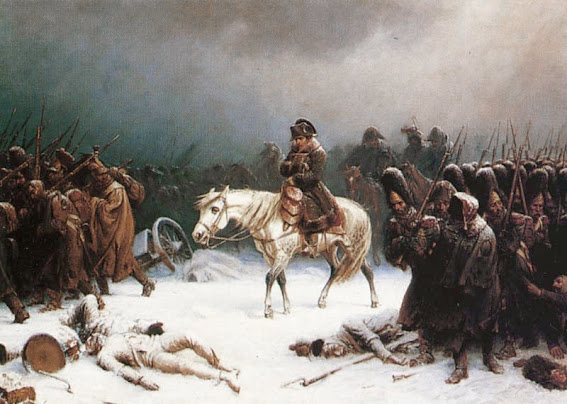In this penultimate episode of Arthro-Pod's 6 part series on the history of insects defeating Napoleon, we travel to Russia! Over the last four episodes, we’ve discussed the French Revolution and Napoleon’s rise to power, the French invasion of Egypt and their encounter with plague, and the Haitian Revolution and crushing defeats the British and French faced due in large part to yellow fever.
Now, hear this one on the effects of typhus on Emperor Napoleon's campaigns near Russia and how he was thwarted by bugs and perhaps a little hubris!
Napoleon leads his troops during the Battle of Austerlitz, which is often regarded as the finest military victory of his career. "The Battle of Austerlitz, 2nd December 1805", 1810, by François Gérard. Via wikimedia, in the public domain.
Napoleon reviews his troops before the Battle of Jena. "Bataille d'Iéna. 14 octobre 1806", 1836, by Jorace Vernet. Via wikimedia, in the public domain.
Execution of Spanish resistance by French forces during the Peninsular War. "The Third of May 1808", 1810, by Francisco Goya. Via wikimedia, in the public domain.
Napoleon as he appeared in 1812 before his defeat in Russia. "The Emperor Napoleon in His Study at the Tuileries ", 1812, by Jacques-Louis David. Via wikimedia, in the public domain.
Heavy 12 pound cannon being serviced by two French Guard Foot. Artist unknown, 1808. Via wikimedia, in the public domain.
The French Empire at it's greatest extent in 1812. Dark green areas were under direct control of France while light green areas were client states. By TRAJAN 117, via wikimedia, used under a CC BY-SA 3.0 license.
Marshal Michel Ney, who begged Napoleon to commit the Imperial Guard during the Battle of Borodino and saved the western bridgehead, and so Napoleon and what remained of the French army, during the Battle of Berezina. "Marshal Michel Ney, duc d'Elchingen, prince de la Moskova", circa 1805, by François Gérard. Via wikimedia, in the public domain.
Attrition in the French Grande Armeé during the 1812 invasion of Russia. While the popular focus is often on the death and privation during the winter retreat, the chart clearly shows how the army was severely weakened even before reaching Moscow. Width of the colored areas the chart correspond to troop strength (1 mm = 10,000 troops). Geographic distance is shown by the scale in the center right ("lieues communes de France" = common French league) = 4444 m or 2.75 miles). Temperatures (in Réaumur scale) on the bottom of the chart correspond to the black line of retreat. (multiply Réaumur temperatures by 1¼ to get Celsius, e.g. -19 °R at Smolensk = -23.75 °C = -10.75 °F). By Charles Minard, 1869. Via wikimedia, in the public domain.
Human louse, the vector of epidemic typhus and trench fever. Photo by Gilles San Martin. Via wikimedia, used under a CC BY-SA 2.0 license.
Macular rash caused by epidemic typhus. Illustration by George Jochmann, 1914. Via wikimedia, used under a CC BY-SA 4.0 license.
Questions? Comments?
Follow the show on Twitter @Arthro_Podshow
Follow the hosts on Twitter @bugmanjon, @JodyBugsmeUNL, and @MSkvarla36
Get the show through Apple Podcasts!
Subscribe to our feed on Feedburner!
We're also on Stitcher!












